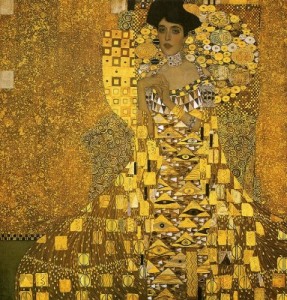Pinky Says: THE STOLEN PORTRAIT OF ADELE BLOCH-BAUER
The world record sale in 2006 of a Gustav Klimt portrait marked the culmination of its sensational journey from the salons of Vienna via the hands of Nazi looters to the Neue Museum in New York. The painting is a portrait of Adele Bloch-Bauer, a beautiful wealthy Austrian woman which took Klimt 3 years and hundreds of drawings to produce. This is a story that fascinates the public not only because at that time it became the world’s most expensive painting but also because it is at the center of a sensational case about Nazi looted art The journey of Adele ended 68 years of injustice. When an arbitration court ruled that Vienna’s state owned Belvedere Gallery must return 5 Klimt paintings to Maria Altmann, a U.S. citizen now living in California who was the last direct relative of their original owner, restitution experts reacted with joy and disbelief. This case was a bitter legal battle that was waged for more than seven years, and it was a classic David and Goliath confrontation that most experts thought impossible to win. A federal court in California and then the U.S. Supreme Court determined that Altmann could sue the Republic of Austria in the U.S. courts for the return of the portrait of Adele Bloch-Bauer which had been stolen by the Nazis in World War II. The Austrian government had claimed immunity as a sovereign nation, but its case was finally turned down. Austria, confronted with a full U.S. trial finally agreed to arbitration and appointed Austrian arbitrators .
Altmann’s ultimate victory was a bad day for the Austrian government, whose government officials had planned and plotted and blocked the return of the Bloch-Bauer Klimts for over 60 years. Losing the art was about so much more than money; it was a terrible blow to Austria’s pride and heritage. Gustave Klimt is an Austrian icon, the most celebrated artist in his lifetime. His works stand as the most important of the Jugendsthil and Secessionist movements and the portrait of Adele is his finest work. It is an elaborately gold embellished canvas and one of Klimt’s most notable masterpieces. Adele is seated as if in a floating sea of gold with signs and symbols as decoration on her mantle that hark back to the Ravenna Byzantine gold mosaics imagery but also look forward with geometric decorations to the future. Rumors abound that Adele and Klimt had a 12 year affair; this portrait took 3 years to complete and almost 200 preparatory drawings so that took up some time. It is known that her arranged marriage was not a happy one; her personal maid and her physician both confirmed the relationship of painter and subject. But to return from the tangential aspects of the story, Adele was the wife of Ferdinand Bloch-Bauer, the owner of Austria’s largest sugar refinery. He assembled the biggest most valuable collections of 17th century porcelain and 19th century Austrian art. Adele inherited a fortune from her banker father. Together they were among Vienna’s moat prominent art patrons. Fin de siecle Vienna rivalled Paris largely through the cultural passions of families such as theirs. The Bloch-Bauers lived in unimaginable luxury in a mansion where all the art including the paintings Ferdinand commissioned from Klimt were displayed. Adele held her famous weekly salons for guests like Gustav and Alma Mahler, Richard Strauss, artists Klimt, Egon Schiele, Kokoschka, the writers Stefan Zweig and Arthur Schnitzler, and leading socialist theoreticians. Yet there was little happiness in the marriage. She was known to be a rather cold intellectual a woman who was very politically aware, but she was childless. Her double niece, Maria Altmann, said she remembered her as extremely elegant tall, dark and thin. When she died of meningitis at the age of 43, her husband turned her bedroom into a memorial chapel hung with all their Klimts and freshly cut flowers.
Niece Maria Altmann married an aspiring opera singer in the last fashionable Jewish wedding before the Germans annexed Austria. Her uncle gave her a diamond necklace and earrings which had belonged to Adele as a wedding present. In the following March, Hitler’s troops marched into Vienna amid ringing bells and jubilant people. One week later a Gestapo official came to her door; he took all her valuables incuding her engagement ring and Adele’s necklace and earrings. These were later presented to Hitler’s deputy, Hermann Goering, as a gift for his wife. The next day her husband was arrested, imprisoned, and later deported to Dachau. His brother Bernhard had a successful cashmere business in Austria, but he had moved to Paris. The Nazis said that they would release Maria’s husband if he signed over his knitwear factory to them. He did so and Fritz was freed. Ferdinand Bloch-Bauer’s assets, including the sugar refinery, his two homes and his art collections had already been seized and he had fled to Switzerland. The Altmanns were under house arrest but they managed to escape to England and then moved to America in 1940. Ferdinand died in 1945. In his will, drawn up several weeks earlier, he named Maria Altmann and her sister and brother as his heirs. However there was virtually nothing of value in the estate. The Vienna mansion was now the headquarters of the Austrian State Railway; shares from the sugar company held in trust under Ferdinand’s name by a Swiss bank had been sold to an investor with Nazi connections; the summer palace in Prague became the chief residence of Reinhard Heydrich, who ruled Czechoslovakia and helped mastermind the “final solution”. After Heydrich’s assassination in 1941, other Germans plundered its treasures and after the war ended the property was sequestered by the Czech communist government. Bloch-Bauer’s art collection had been divided up; many works had been presented to Hitler, Goering and other deputies while ohers lay in a German depot with thousands of looted artworks earmarked for Hitler’s planned musuem in Linz. Maria Altmann said that the porcelain collection had been auctioned off. She knew that everything was gone but she was busy with 3 small children and struggling to make a living. They did hire a lawyer but he found that the heirs had no claim to the Klimts, because they had been donated to the Belvedere Gallery allegedly under the terms of Adele’s will. The heirs did not ever see the will but assumed that this was so. …………continued tomorrow, July 30th.



Leave a Reply